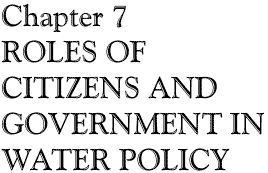
| ch. 7, pp. 103 - 105 |
REGIONAL WATER QUALITY PLANNING The Pima Association of Governments (PAG) is responsible for coordinating water quality and transportation planning as well as regional population projections. Each local government entity, regardless of its size, has one vote on PAG decisions. An Environmental Planning Advisory Committee and its Water Quality Subcommittee, which is made up of government staff and local residents, study and make recommendations on such matters as new wastewater treatment facilities, water reclamation and pollution cleanup. PAG votes on their recommendations to determine whether they become policy. Both Pima County and the City of Tucson are involved in flood control and the development and enforcement of floodplain ordinances. Pima County’s flood control district (FCD) is governed by the Board of Supervisors acting in its capacity as Pima County FCD managers. Established by state statute in 1978, county flood control districts work to reduce the risk of flood loss, minimize the impact of floods on human safety, health and welfare, and restore and preserve the natural and beneficial values served by floodplains. Established as political taxing subdivisions of the state, FCDs have the power to levy taxes to support flood-control projects. Their area of jurisdiction may include incorporated and unincorporated areas. Legislation also allows an incorporated city or town within a county to assume responsibility for its floodplain management. Tucson maintains its own floodplain management program within Pima County. Pima County FCD is mainly concerned with areas outside city limits. Intergovernmental agreements (IGAs) have been signed with the city, however, for the district also to be responsible for waterways within certain incorporated areas. IGAs are likely to be worked out for regional watercourses that have significant flow during 100-year flood events, such as the Rillito Creek and the Santa Cruz River. Pima County therefore maintains the major watercourses in the area, although the city may be responsible for sections of them. Finally, floodplain maps are under the jurisdiction of the Federal Emergency Management Agency (FEMA) which administers the national flood insurance program. Communities that do not comply with FEMA rules are not eligible for federal flood insurance. Counties generally have only those powers granted to them by the state, unless they have adopted charter government. Counties are required to look after the “health, safety, and welfare” of their residents. As a result, they maintain health departments, building codes, etc. Counties do not currently have the authority to operate water systems. Pima County has a department of environmental quality which is primarily involved with air quality and hazardous waste. County health departments have some water quality responsibilities related to human health; e.g., they regulate septic tanks. County zoning decisions may be based on the ability of government to provide services such as wastewater treatment. In at least one case a massive rezoning was denied on the basis of an insufficient water supply, the lack of which could have been a serious health problem. Cities have varied levels of involvement in water management. Some cities (e.g., Tucson) operate water companies, and many cities operate wastewater facilities (e.g., Show Low). Many cities have water conservation programs (e.g., Phoenix). Cities and counties may assess fees on new development (impact fees) to recover the cost of providing services to the new area. Such services include water and wastewater facilities. Both cities and counties operate under state and federal water quality and quantity laws. City and County Ordinances Cities and counties also have their own laws, referred to as ordinances. In general, these ordinances may be stricter than state or federal ones, but may not be less strict. Thus a city cannot opt out of following the Safe Drinking Water Act, but it can decide to meet more stringent standards, such as the tighter THM standard that the City of Tucson has imposed on itself. On occasion, however, the state government has preempted this right. Water Consumer Protection Act The Water Consumer Protection Act (WCPA), a ballot proposition passed by City of Tucson voters in 1995, (See page ) had three major goals:
Other goals included:
In 1997, Proposition 201 was on the ballot but failed to pass. It would have repealed many of the provisions of the WCPA, substituting less restrictive goals.
|
